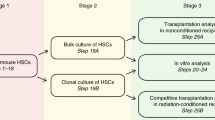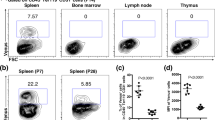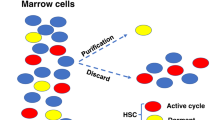Abstract
Certain cells (CFU-S) in the haematopoietic tissues of mice are able to form macroscopic nodules in the spleen 7–14 days after injection in heavily irradiated recipient mice1. At 7–9 days, most of the spleen colonies contain recognizable cells of one predominant haematopoietic lineage2, and do not contain cells capable of spleen colony formation on injection in secondary hosts3. However, by 14 days most of the spleen colonies do contain cells of more than one line of haematopoietic differentiation2, as well as precursor cells capable of again generating similar multilineal spleen colonies on retransplantation3. These observations have led to the widely accepted conclusion that most spleen colonies are derived from pluripotential ‘stem’ cells3, and to the suggestion that the apparent transformation in character of spleen colonies from unilineal at early times to mixed later on reflects the local operation of ‘instructive’ differentiative signals in the splenic environment2. The reasoning behind these suggestions implicitly assumed that late colonies simply represented a further stage in the development of the same colonies observable at earlier times. Here, we present direct evidence against this assumption. Our data indicate that most spleen colonies identified as surface nodules at days 7–8 are neither multipotential nor self-maintaining, but rather are destined to disappear from the spleen within 72 h. The observations set limits on the validity of the spleen colony method as an assay for self-maintaining pluripotential progenitor cells, and give cause for reassessment of the data on which widely accepted views concerning the regulation of such cells are based.
This is a preview of subscription content, access via your institution
Access options
Subscribe to this journal
Receive 51 print issues and online access
$199.00 per year
only $3.90 per issue
Buy this article
- Purchase on Springer Link
- Instant access to full article PDF
Prices may be subject to local taxes which are calculated during checkout
Similar content being viewed by others
References
Till, J. E. & McCulloch, E. A. Radiat. Res. 14, 213 (1961).
Curry, J. L. & Trentin, J. J. Devl Biol. 15, 395 (1967).
Siminovitch, L., McCulloch, E. A. & Till, J. E. J. cell. comp. Physiol. 62, 327 (1963).
Gregory, C. J. & Henkelman, R. M. in Experimental Hematology Today (eds Baum, S. J. & Ledney, G. D.) 93 (Springer, New York, 1977).
Iscove, N. N. in Hematopoietic Cell Differentiation (eds Golde, D. W., Cline, M. J., Metcalf, D. & Fox, C. F.) 37 (Academic, New York, 1978).
Gregory, C. J., McCulloch, E. A. & Till, J. E. J. cell Physiol 86, 1 (1975).
Hodgson, G. S. & Bradley, T. R. Nature 281, 381 (1979).
Iscove, N. N., Guilbert, L. J. & Weyman, C. Expl Cell Res. 126, 121 (1980).
Ralph, P. & Nakoinz, I. Cancer Res. 37, 546 (1977).
Robinson, C. V. Proc. Soc. exp. Biol. Med. 124, 118 (1967).
Boggs, S. S., Chervenick, P. A. & Boggs, D. R. Blood 40, 375 (1972).
Author information
Authors and Affiliations
Rights and permissions
About this article
Cite this article
Magli, M., Iscove, N. & Odartchenko, N. Transient nature of early haematopoietic spleen colonies. Nature 295, 527–529 (1982). https://doi.org/10.1038/295527a0
Received:
Accepted:
Issue Date:
DOI: https://doi.org/10.1038/295527a0
This article is cited by
-
Hematopoiesis in the spleen after engraftment in unrelated cord blood transplantation evaluated by 18F-FLT PET imaging
International Journal of Hematology (2023)
-
Isolation, selection and culture methods to enhance clonogenicity of mouse bone marrow derived mesenchymal stromal cell precursors
Stem Cell Research & Therapy (2015)
-
When one cell is enough
Stem Cell Research & Therapy (2012)
-
Stems and Standards: Social Interaction in the Search for Blood Stem Cells
Journal of the History of Biology (2010)
-
Hematopoietic stem cell and multilineage defects generated by constitutive β-catenin activation
Nature Immunology (2006)
Comments
By submitting a comment you agree to abide by our Terms and Community Guidelines. If you find something abusive or that does not comply with our terms or guidelines please flag it as inappropriate.



